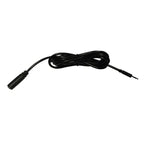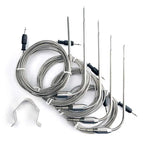FireBoard Ambient Probe — Frequently Asked Questions
What is the FireBoard Ambient Probe?
The FireBoard Ambient Probe is a sensor designed to measure the ambient (air) temperature inside a grill, smoker, oven, or other cooking chamber environment. It connects to your FireBoard controller (or compatible device) to provide real-time ambient temperature feedback.
What are its specifications and performance limits?
• Probe length: 2 ¼″ (approx. 2.25")
• Probe diameter: ~⅛″ (4 mm)
• Cable length: 6 ft (approx) with 2.5 mm audio connector
• Temperature range (thermistor version): 0 to 572 °F (–18 to 300 °C)
• Threaded variant (SA311T) available: ¼″ BSP threading for fixed mounting
• Compatible with FireBoard support for thermistor or RTD probes depending on your model.
How do I install and use the ambient probe?
1. Choose a location inside the cooking chamber (away from direct flame or contact surfaces).
2. Use mounting clips (sold separately) or threaded mount (if you have the threaded version) for secure positioning.
3. Plug the probe into a compatible ambient sensor port on your FireBoard or controller via the 2.5 mm audio jack.
4. In your FireBoard app or firmware, set the probe type (thermistor / RTD / ambient) for the proper scaling.
5. Monitor ambient readings to understand how your cooking chamber is performing, and use it to help adjust vents, heat, or fuel accordingly.
What are the benefits and limitations?
Benefits:
• Helps monitor and control the internal air temperature reliably.
• Compatible with FireBoard systems for integrated temperature logging and alerts.
• Multiple variants (threaded or clip) allow flexibility in mounting.
Limitations / cautions:
• Thermistor version has an upper limit of ~572 °F — exceeding that may damage or misread.
• Avoid placing too close to heating elements, flame, or hot surfaces to prevent reading bias or probe damage.
• Ensure proper calibration and configuration in the FireBoard software so the reading is accurate.
• Cable quality, connection stability, and positioning may influence accuracy, especially in fluctuating conditions.




